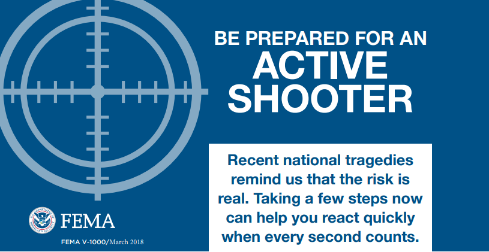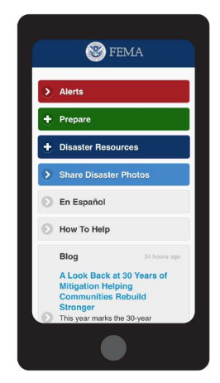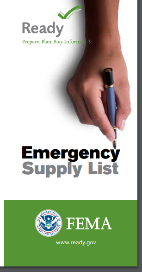 ACTSmart has gathered a few of the many ways that you can prepare for emergencies.
ACTSmart has gathered a few of the many ways that you can prepare for emergencies.
We hope you’ll take a few moments to look over this information – it may save your life!
Basic Disaster Supplies Kit Checklist
To assemble your kit, store items in airtight plastic bags and put your entire disaster supplies kit in one or two easy-to-carry containers such as plastic bins or a duffel bag.
√ https://www.ready.gov/build-a-kit
A basic emergency supply kit could include the following recommended items:
-
- Water – one gallon of water per person per day for at least three days, for drinking and sanitation
- Food – at least a three-day supply of non-perishable food
- Battery-powered or hand crank radio and a NOAA Weather Radio with tone alert
- Flashlight
- First aid kit
- Extra batteries
- Whistle to signal for help
- Dust mask to help filter contaminated air and plastic sheeting and duct tape to shelter-in-place
- Moist towelettes, garbage bags and plastic ties for personal sanitation
- Wrench or pliers to turn off utilities
- Manual can opener for food
- Local maps
- Cell phone with chargers and a backup battery
- Additional Emergency Supplies
Additional Emergency Supplies
Since Spring of 2020, the Centers for Disease Control and Prevention (CDC) has recommended people include additional items in their kits to help prevent the spread of coronavirus or other viruses and the flu.
Consider adding the following items to your emergency supply kit based on your individual needs:
- Masks (for everyone ages 2 and above), soap, hand sanitizer, disinfecting wipes to disinfect surfaces
- Prescription medications. About half of all Americans take a prescription medicine every day. An emergency can make it difficult for them to refill their prescription or to find an open pharmacy. Organize and protect your prescriptions, over-the-counter drugs, and vitamins to prepare for an emergency.
- Non-prescription medications such as pain relievers, anti-diarrhea medication, antacids or laxatives
- Prescription eyeglasses and contact lens solution
- Infant formula, bottles, diapers, wipes and diaper rash cream
- Pet food and extra water for your pet
- Cash or traveler’s checks
- Important family documents such as copies of insurance policies, identification and bank account records saved electronically or in a waterproof, portable container
- Sleeping bag or warm blanket for each person
- Complete change of clothing appropriate for your climate and sturdy shoes
- Fire extinguisher
- Matches in a waterproof container
- Feminine supplies and personal hygiene items
- Mess kits, paper cups, plates, paper towels and plastic utensils
- Paper and pencil
- Books, games, puzzles or other activities for children
Kit Storage Locations
Since you do not know where you will be when an emergency occurs, prepare supplies for home, work and vehicles.
- Home: Keep this kit in a designated place and have it ready in case you have to leave your home quickly. Make sure all family members know where the kit is kept.
- Work: Be prepared to shelter at work for at least 24 hours. Your work kit should include food, water and other necessities like medicines, as well as comfortable walking shoes, stored in a “grab and go” case.
- Vehicle: In case you are stranded, keep a kit of emergency supplies in your car.
![]()
Create Your Family Emergency Communications Plan –
https://www.ready.gov/sites/default/files/2021-04/family-emergency-communication-plan.pdf
Active Shooter Guide
 What to do if you find yourself in an active shooting event, how to recognize signs of potential violence around you, and what to expect after an active shooting takes place. Remember during an active shooting to RUN. HIDE. FIGHT.
What to do if you find yourself in an active shooting event, how to recognize signs of potential violence around you, and what to expect after an active shooting takes place. Remember during an active shooting to RUN. HIDE. FIGHT.
√ https://www.ready.gov/active-shooter
Be Informed
Sign up for an active shooter training.
If you see something, say something to an authority right away.
Sign up to receive local emergency alerts and register your work and personal contact information with any work sponsored alert system.
Be aware of your environment and any possible dangers.
Make a Plan
Make a plan with your family, and ensure everyone knows what they would do, if confronted with an active shooter.
Look for the two nearest exits anywhere you go, and have an escape path in mind & identify places you could hide.
Understand the plans for individuals with disabilities or other access and functional needs.
During
RUN and escape if possible
HIDE if escape is not possible
FIGHT as an absolute last resort
After
- Keep hands visible and empty.
- Know that law enforcement’s first task is to end the incident, and they may have to pass injured along the way.
- Officers may be armed with rifles, shotguns, and/or handguns and may use pepper spray or tear gas to control the situation.
- Officers will shout commands and may push individuals to the ground for their safety.
- Follow law enforcement instructions and evacuate in the direction they come from, unless otherwise instructed.
- Take care of yourself first, and then you may be able to help the wounded before first responders arrive.
- If the injured are in immediate danger, help get them to safety.
- While you wait for first responders to arrive, provide first aid. Apply direct pressure to wounded areas and use tourniquets if you have been trained to do so.
- Turn wounded people onto their sides if they are unconscious and keep them warm.
- Consider seeking professional help for you and your family to cope with the long-term effects of the trauma.
Get Tech Ready
 Technology has made it easier than ever to prepare for emergencies, but it can be unreliable during emergency circumstances if you haven’t planned to keep your gadgets protected and powered up. Here are some tips to make sure you are tech ready:
Technology has made it easier than ever to prepare for emergencies, but it can be unreliable during emergency circumstances if you haven’t planned to keep your gadgets protected and powered up. Here are some tips to make sure you are tech ready:
√ https://www.ready.gov/get-tech-ready
Be Informed
- Download the FEMA app. Receive weather alerts from the National Weather Service for up to five different locations anywhere in the United States.
- Sign up for FEMA text messages. Use your cell phone’s text messaging capability to receive text message updates from FEMA (standard message and data rates apply).
Here are basic commands to get started:
- To sign up to receive preparedness tips: text PREPARE to 43362
- To search for open shelters (for disaster survivors): text SHELTER and a Zip Code to 43362
- List of all keywords you can subscribe to: text LIST to 43362
- To unsubscribe (at any time): text STOP to 43362
- Before a disaster, follow local government on social media to stay up-to-date with official information before, during, and after a disaster. Sign up for Twitter Alerts from trusted government agencies to get notified when critical information goes out. Visit the Alerts setup page of the agency you want to receive notifications from (ex: twitter.com/fema/alerts).
Make A Plan
- Use text messages, social media and email to connect with friends and family during emergencies.
- Mobile networks can become overwhelmed during emergencies, making it difficult to place and receive phone calls. Text messages require less bandwidth, which means they are able to be transmitted more reliably during situations when many people are trying to use their mobile phones at the same time.
- Social media channels such as Facebook and Twitter can also be an effective way to update family and friends during emergencies. Facebook’s Safety Check feature allows users to easily post a status update indicating that they are safe during a time of disaster.
- Register with American Red Cross’s Safe & Well site to let family and friends know you’re okay..
After registering, you can select a message to let family and friends know you’re OK. Concerned family and friends can search this list to find their loved one’s first name, last name, an “as of date” and the “safe and well” message. - Have an emergency charging option for your phone and other mobile devices.
Smartphones have become a vital tool to receive emergency alerts and warnings, so it’s important to make sure you can keep them powered up in an emergency.-
- At home: Prior to severe weather, make sure that all of your electronic devices are fully charged. If the power goes out, preserve battery power by minimizing device use. Keep a back-up power source on hand to recharge your phone so that you can stay connected even during an extended power outage.
- In your car: Keep a portable phone charger in your vehicle at all times, and consider purchasing a back-up power supply to keep in your vehicle as well.
- Change the settings on your phone to low power mode or place it on airplane mode to conserve energy.
-
- Store important documents in a secure, password-protected jump drive or in the cloud.
- There are a number of productivity apps for mobile devices that make this easier than ever, using your phone’s camera as a scanning device. Capture electronic versions of important documents such as insurance policies, identification documents, and medical records. Don’t forget to include your pet’s information.
- Back-up your computer to protect photos and other personally important electronic documents.
- Scan old photos to protect them from loss.
- Keep your contacts updated and synced across all of your channels, including phone, email and social media. This will make it easy to reach out to the right people quickly to get information and supply updates. Consider creating a group listserv of your top contacts.
- Create a group chat via a texting app or a thread for family/friends/coworkers to communicate quickly during a disaster.
- Sign up for Direct Deposit and electronic banking through your financial institution so you can access your payroll funds and make electronic payments wherever you are. Federal benefit recipients can sign up by calling (800) 333-1795 or at GoDirect.org.
~~~~~~~~~~~~~~~~~~~~~~~~~~~~~~~~~~~~~~~~~~~~~~~~~~~~~~~~~~~~~~~~~~~~

Is your critical business data protected and available in the event of a disaster? Click HERE for more information…
Being prepared by protecting your critical data has never been more crucial!
User error, malicious deletion, natural disasters, and cyber-attacks can all threaten your business. Today’s complex infrastructures and targeted cyber-attacks require a complete backup strategy that protects data wherever it resides— on‑premises or in the cloud.
Ransomware protection—without paying the ransom.
Don’t let criminals hold your data hostage. With ACTSmart IT’s Data Guardian, recovering your data is as simple as eliminating the malware, deleting the criminally encrypted files, and restoring a good copy of your precious data.
ACTSmart Data Guardian – Complete backup, disaster recovery and business continuity!
Data Guardian is a network attached storage device that backs up your server locally and off site. “Snapshots” are taken every 15 minutes to minimize potential data loss
- Back in business within 20 minutes
- With off-site backup, a new server can be delivered next day to location of your choice. System is imaged from the last offsite backup
- Able to restore to dis-similar hardware (new computer doesn’t have to match the old computer) Restore individual files, folders or individual emails
- For more information about our ACTSmart IT Data Guardian, Call 855-WOW-SERVICE


